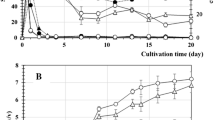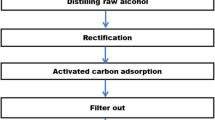Abstract
In this paper, an optimal semi-continuous process for vinegar production from edible alcohol through biotransformation by acetic acid bacteria (AAB) WUST-01 was developed. The optimized medium composition for the starting-up stage was glucose 5.1 g/L, yeast extract 26.2 g/L, and ethanol 11.9 mL/L, and the optimal ethanol for the following semi-continuous stage was 50 mL/L. In the semi-continuous biotransformation process, the optimal withdraw ratio was 50% of working volume with 12 h cycle time. With these conditions, the total acidity could reach to 77.3 g/L and the acidity productivity could reach to 3.0 g/(L h) in a 5 L reactor. Furthermore, it was investigated to strengthen vinegar synthesis through enhancing alcohol dehydrogenase and aldehyde dehydrogenase activity in AAB by ferrous ion and pueraria flower extract as the enzyme regulators. With these regulators, the vinegar synthesis efficiency can be improved 16.3 and 13.2% respectively.




Similar content being viewed by others
References
Ho CW, Lazim AM, Fazry S, Zaki UK, Lim SJ. Varieties, production, composition and health benefits of vinegars: A review. Food Chem. 221:1621–1630 (2017)
Torija M, Mateo E, Vegas C. Effect of wood type and thickness on acetification kinetics in traditional vinegar production. Int. J. Wine Res. 1:155–160 (2009)
Maria G, Elena V, Matteo C. Aerobic submerged fermentation by acetic acid bacteria for vinegar proguction: Process and biotechnological aspects. Process Biochem. 49:1571–1579 (2014)
Natsaran S, Kazunobu M, Osao A, Ivo F, Jitka F. Acetic acid bacteria: A group of bacteria with versatile biotechnological applications. Biotechnol. Adv. 33:1260–1271 (2015)
Tesfaye W, Morales ML, Garcia PM, Troncoso AM. Wine vinegar: Technology, authenticity and quality evaluation. Trends Food Sci. Technol. 13:12–21 (2002)
Jo Y, Baek JY, Jeong IY, Jeong YJ, Yeo SH, Noh B, Kwon JH. Physicochemical properties and volatile components of wine vinegars with high acidity based on fermentation stage and initial alcohol concentration. Food Sci. Biotechnol. 24:445–452 (2015)
Schleputz T, Buchs J. Investigation of vinegar production using a novel shaken repeated batch culture system. Biotechnol. Prog. 29:1158–1168 (2013)
Qi Z, Yang H, Xia X, Quan W, Wang W, Yu X. Achieving high strength vinegar fermentation via regulating cellular growth status and aeration strategy. Process Biochem. 49:1063–1070 (2014)
Qi Z, Dong D, Yang H, Xia X (2017) Improving fermented quality of cider vinegar via rational nutrient feeding strategy. Food Chem. 224:312–319.
Qi ZL, Yang HL, Xia XL, Wang W, Yu XB. High strength vinegar fermentation by Acetobacter pasteurianus via enhancing alcohol respiratory chain. Biotechnol. Bioprocess Eng. 19:289–297 (2014)
De OL, Romero LE, Cantero D. Optimum starting-up protocol of a pilot plant scale acetifier for vinegar production. Food Eng. 52:31–37 (2002)
Yakushi T, Matsushita K. Alcohol dehydrogenase of acetic acid bacteria: Structure, mode of action, and applications in biotechnology. Appl. Microbiol. Biotechnol. 86(5):1257–1265 (2010)
Lechardeur D, Cesselin B, Fernandez A, Lamberet G, Garrigues C, Pedersen M, Gaudu P, Gruss A. Using heme as an energy boost for lactic acid bacteria. Curr. Opin. Biotechnol. 22:143–149 (2011)
Lu J, Li W, Ni Y. Studies on the effect of water extracts of 8 different chinese herbal medicines on alcohol dehydrogenase activity. J. Tongji Univ. (Med. Sci.) 23(1):23–24, 30 (2002) (in Chinese)
Adachi O, Tayama K, Shinagawa E, Matsushita K, Ameyama M. Purification and characterization of particulate alcohol dehydrogenase from Gluconobacter suboxydans. Agric. Biol. Chem. 42:2045–2056 (1987)
Adachi O, Tayama K, Shinagawa E, Matsushita K, Ameyama M. Purification and characterization of membranebound aldehyde dehydrogenase from Gluconobacter suboxydans. Agric. Biol. Chem. 44:503–515 (1980)
Dorini FA, Cecconello MS, Dorini LB. On the logistic equation subject to uncertainties in the environmental carrying capacity and initial population density. Commun. Nonlinear Sci. Numer. Simul. 33:160–173 (2016)
Liu JZ, Weng LP, Zhang QL, Xu H, Ji LN. A mathematical model for gluconic acid fermentation by Aspergillus niger. Biochem. Eng. J. 14:137–141 (2003)
Qi Z, Yang H, Zhang L, Leng Y, Quan W, Wang W. Study on the technology of high-acidity rice vinegar sumberged fermentation. J. Food Sci. Technol. 29:911–915 (2010) (in Chinese)
Acknowledgements
The present work was financed by the National Natural Science Foundation of China (Grant No. 21376184), the Scientific Research Foundation for the Returned Overseas Chinese Scholars (State Education Ministry), Foundation from Educational Commission of Hubei Province of China (Grant No. D20121108) and the Innovative Team of Bioaugmentation and Advanced Treatment on Metallurgical Industry Wastewater.
Author information
Authors and Affiliations
Corresponding author
Electronic supplementary material
Below is the link to the electronic supplementary material.
Rights and permissions
About this article
Cite this article
Yin, XY., Zhong, WK., Huo, J. et al. Production of vinegar using edible alcohol as feedstock through high efficient biotransformation by acetic acid bacteria. Food Sci Biotechnol 27, 519–524 (2018). https://doi.org/10.1007/s10068-017-0283-z
Received:
Revised:
Accepted:
Published:
Issue Date:
DOI: https://doi.org/10.1007/s10068-017-0283-z




